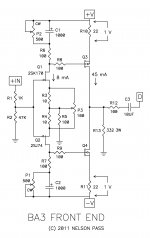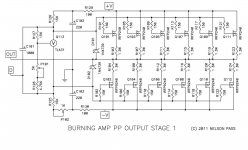BA-3 output stage holds the bias circuit a little differently, look at C1 and the diodes and where the gian stage drives it.
The Output buffers you ask about are all essentially identical - they are IRF240/9240 push pull followers. Followers don't impart much signature at all to the circuit. Which means they will all sound very similar, and that sound will pretty much be like whatever you drive them with.
The Output buffers you ask about are all essentially identical - they are IRF240/9240 push pull followers. Followers don't impart much signature at all to the circuit. Which means they will all sound very similar, and that sound will pretty much be like whatever you drive them with.
Refering to the BA PP output and gain stage I don't understand your explanation about C1
It seems the same as F4 and M2View attachment 656383
View attachment 656384
From the Firstwatt BA-3 article.
http://www.firstwatt.com/pdf/art_ba_3.pdf
Coming off the Drain of Q1 is the loading network of R6, C1 and P1, and there is a
comparable network of R7, C2, and P2 attached to the Drain of Q2. R6 clearly sets the AC
load for Q1, but the DC requirements to bias up Mosfet Q3 are higher than that, so P1 in
parallel with C1 provides a higher resistance value below about 0.5 Hz, and gives the
approximately 3 volt DC drop required to bias the Mosfets
I am referring to the BA output stage vs the F4 and M2
The BA-3 gain stage is cap coupled to the output stage has nothing to do with bias and ground reference
The BA-3 gain stage is cap coupled to the output stage has nothing to do with bias and ground reference
any substitute for input Jfets? as they are only buffer, some lower transconductance jfets could still give good performance
why asking same thing in more than one thread ?
somebody will answer
But... Can it drive a F4?
any substitute for input Jfets? as they are only buffer, some lower transconductance jfets could still give good performance
You can remove them entirely if your source has a reasonably low
output impedance.
Power Supply and Power Cord
As I Class A novice, I'm struggling to understand the requirements for a Class A amp (F4 for example) in the power supply department. My understanding is that the F4 takes a constant 180 watts and that the speaker output power is super imposed on that. I admit to being a bit foggy on that last part. Anyway, that would mean less than 2 amps at any time and insignificant resistance to a standard 6 foot cable.
Because the output to the speaker is the same regardless of the bias power, the F4 should have at least equal, perhaps even lower, dynamic power supply requirement in comparison to a Class AB amp. Is this true?
I'm curious about this because of an unexpected result. Listening to my Impasse F4 combination, there has been a little haze or blurriness on dynamic music passages. I have been trying different things to understand what might reduce the haze.
When I first started testing, I grabbed the first power cable in the box and it happened to be an old Apple iMac cord (guessing, but probably 18 gauge) and it has stayed in place since the beginning. So this evening, I decided to swap in a 3 x 14 AWG power cord and was surprised to find the haze seemed reduced. I fully admit that this might be subjective hog wash and wishful thinking. But so far, I'm having trouble convincing my self that the improvement isn't there, even though it doesn't fit with my understanding of how a Class A power supply should work.
For reference, the power supply is a diyAudio store pcb with all cap positions filled with 22 mF capacitors and 4x 0.47R resistors in parallel.
Please. Educate me.
Jac
As I Class A novice, I'm struggling to understand the requirements for a Class A amp (F4 for example) in the power supply department. My understanding is that the F4 takes a constant 180 watts and that the speaker output power is super imposed on that. I admit to being a bit foggy on that last part. Anyway, that would mean less than 2 amps at any time and insignificant resistance to a standard 6 foot cable.
Because the output to the speaker is the same regardless of the bias power, the F4 should have at least equal, perhaps even lower, dynamic power supply requirement in comparison to a Class AB amp. Is this true?
I'm curious about this because of an unexpected result. Listening to my Impasse F4 combination, there has been a little haze or blurriness on dynamic music passages. I have been trying different things to understand what might reduce the haze.
When I first started testing, I grabbed the first power cable in the box and it happened to be an old Apple iMac cord (guessing, but probably 18 gauge) and it has stayed in place since the beginning. So this evening, I decided to swap in a 3 x 14 AWG power cord and was surprised to find the haze seemed reduced. I fully admit that this might be subjective hog wash and wishful thinking. But so far, I'm having trouble convincing my self that the improvement isn't there, even though it doesn't fit with my understanding of how a Class A power supply should work.
For reference, the power supply is a diyAudio store pcb with all cap positions filled with 22 mF capacitors and 4x 0.47R resistors in parallel.
Please. Educate me.
Jac
The output impedance of a power supply certainly will have an effect.
At least certainly a measurable effect.
At least certainly a measurable effect.
I hope you're constantly breathing
precisely , in AC manner - in and out
I believe you're feeling much better , and functioning much better (even if just sitting in front of screen and typing ) if no one is chokin' ya .
🙂
flow of energy is of happier level when not constipated

precisely , in AC manner - in and out
I believe you're feeling much better , and functioning much better (even if just sitting in front of screen and typing ) if no one is chokin' ya .
🙂
flow of energy is of happier level when not constipated

Then you need the Jfets. The raw F4 output stage is OK up to about 1K source.
Could you suggest me replacing fest for the input or another imput stage not using the unobtainium 170/74?
Sure, read the B1 thread from Post #44 on for a few pages. Post your ideas and somebody here will help you.Could you suggest me replacing fest for the input or another imput stage not using the unobtainium 170/74?
Then you need the Jfets. The raw F4 output stage is OK up to about 1K source.
using only one pair of IRFPs and changing the bias resistors to 20K (or more?) what would be the max output impedance of the source to drive the F4 without input buffer?
- Home
- Amplifiers
- Pass Labs
- F4 power amplifier

